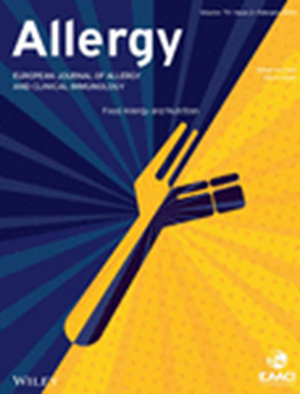利来替尼治疗斑秃亚型的多组学分析及疗效相关性研究。
IF 12.6
1区 医学
Q1 ALLERGY
引用次数: 0
摘要
背景斑秃(AA)是一种以脱发为特征的自身免疫性疾病。本研究检测了AA亚型(斑驳型AA [AAP]或完全性脱发/普遍性脱发[AT/AU])患者病变头皮的分子特征在JAK3/TEC家族激酶抑制剂利来替尼治疗后的变化,并评估了潜在生物标志物水平/变化与头皮毛发再生之间的相关性。方法:这是一项对利来替尼在AA和≥50%头皮脱发患者中进行的2a期试验的活检亚研究的事后分析。使用微阵列分析AAP或AT/AU患者头皮样本的转录组表达谱。评估转录和血清蛋白表达的基线变化,以及这些变化与基线临床反应(头皮毛发再生)之间的相关性。结果治疗12周和24周后,利来替尼下调了AAP和AT/AU病变中关键的I型(CCL5、CD8A和GZMB)和II型免疫相关基因(CCL13、CCL18和IL13RA1),下调了利来替尼作用机制相关基因(ITK、JAK3和BTK),上调了毛发角蛋白基因,AT/AU病变中的上调幅度小于AAP病变。与I型和II型免疫、毛发结构/功能和利来替尼作用机制相关的基因和血清蛋白水平的基线表达水平和从基线到12周和/或24周的变化与12周和/或24周的临床反应显著相关。结论利来替尼治疗可改善AA病变头皮的基因表达谱,并与随后的毛发再生反应相关。REGISTRATIONNCT02974868审判。本文章由计算机程序翻译,如有差异,请以英文原文为准。
Multiomics Analysis of the Response to Ritlecitinib in Alopecia Areata Subtypes and Correlation With Efficacy.
BACKGROUND
Alopecia areata (AA) is an autoimmune disease characterized by hair loss. This study examined changes in molecular signatures in lesional scalp of patients with AA subtypes (patchy-type AA [AAP] or alopecia totalis/alopecia universalis [AT/AU]) in response to treatment with JAK3/TEC family kinase inhibitor ritlecitinib and evaluated correlations between potential biomarker levels/changes and scalp hair regrowth.
METHODS
This was a post hoc analysis of a biopsy substudy from a phase 2a trial of ritlecitinib in patients with AA and ≥ 50% scalp hair loss. Transcriptomic expression profiles from scalp samples of patients with AAP or AT/AU were analyzed using microarray. Changes from baseline in transcriptional and serum protein expression were evaluated, as were correlations between both these changes and the baseline profile with clinical response (scalp hair regrowth).
RESULTS
Following 12 and 24 weeks of treatment, ritlecitinib downregulated key Type I (CCL5, CD8A, and GZMB) and Type II immunity-related genes (CCL13, CCL18, and IL13RA1), downregulated genes related to ritlecitinib's mechanism of action (ITK, JAK3, and BTK), and upregulated hair keratin genes in AAP and AT/AU lesions, with a lesser extent in AT/AU than AAP lesions. Baseline expression levels and changes from baseline to Weeks 12 and/or 24 in levels of genes and serum proteins related to Type I and II immunity, hair structure/function, and ritlecitinib's mechanism of action significantly correlated with clinical response at Weeks 12 and/or 24.
CONCLUSION
These results provide support that treatment with ritlecitinib improves the gene expression profile in AA lesional scalp and is correlated with subsequent hair regrowth response.
TRIAL REGISTRATION
NCT02974868.
求助全文
通过发布文献求助,成功后即可免费获取论文全文。
去求助
来源期刊

Allergy
医学-过敏
CiteScore
26.10
自引率
9.70%
发文量
393
审稿时长
2 months
期刊介绍:
Allergy is an international and multidisciplinary journal that aims to advance, impact, and communicate all aspects of the discipline of Allergy/Immunology. It publishes original articles, reviews, position papers, guidelines, editorials, news and commentaries, letters to the editors, and correspondences. The journal accepts articles based on their scientific merit and quality.
Allergy seeks to maintain contact between basic and clinical Allergy/Immunology and encourages contributions from contributors and readers from all countries. In addition to its publication, Allergy also provides abstracting and indexing information. Some of the databases that include Allergy abstracts are Abstracts on Hygiene & Communicable Disease, Academic Search Alumni Edition, AgBiotech News & Information, AGRICOLA Database, Biological Abstracts, PubMed Dietary Supplement Subset, and Global Health, among others.
 求助内容:
求助内容: 应助结果提醒方式:
应助结果提醒方式:


